Deux figurines de la bataille de Maiwand, 27 Juillet 1880.
La bataille fut un désastre pour une petite armée indienne britannique de 2500 hommes, commandés par le général Burrows, qui a cru à tort qu'il se heurte à une force plus petite afghane. En fait, il avait trébuché sur l'armée afghane principale de 25.000 hommes, disposant d'une artillerie moderne et fusils.
Après un duel de puissance de feu d'une durée d'environ trois heures, l'artillerie sur le flanc gauche retiré pour obtenir plus de munitions. Les ghazis afghanes ont saisi leur moment, le dépassement du flanc gauche, et toute la ligne s'est effondré.
Dans la déroute confuse, un petit parti de la 66e régiment fait une dernière dans un jardin, mais ont tous été tués, et les drapeaux du régiment ont été capturés.
Les restes de l'armée se retira dans Kandahar. Ils avaient perdu environ 1000 hommes.
Les figurines sont entièrement fait sur mesure, et représentent un soldat de la 66e (Berkshire) régiment, et le canonnier James Collis de la Royal Horse Artillery, qui a reçu la Croix de Victoria pour son comportement pour sauver les hommes blessés lors de la retraite.
Private, 66th ( Berkshire ) Regiment 1880 .
Gunner, E/B Battery RHA 1880 .
The Battle of Maiwand , 27 July 1880 .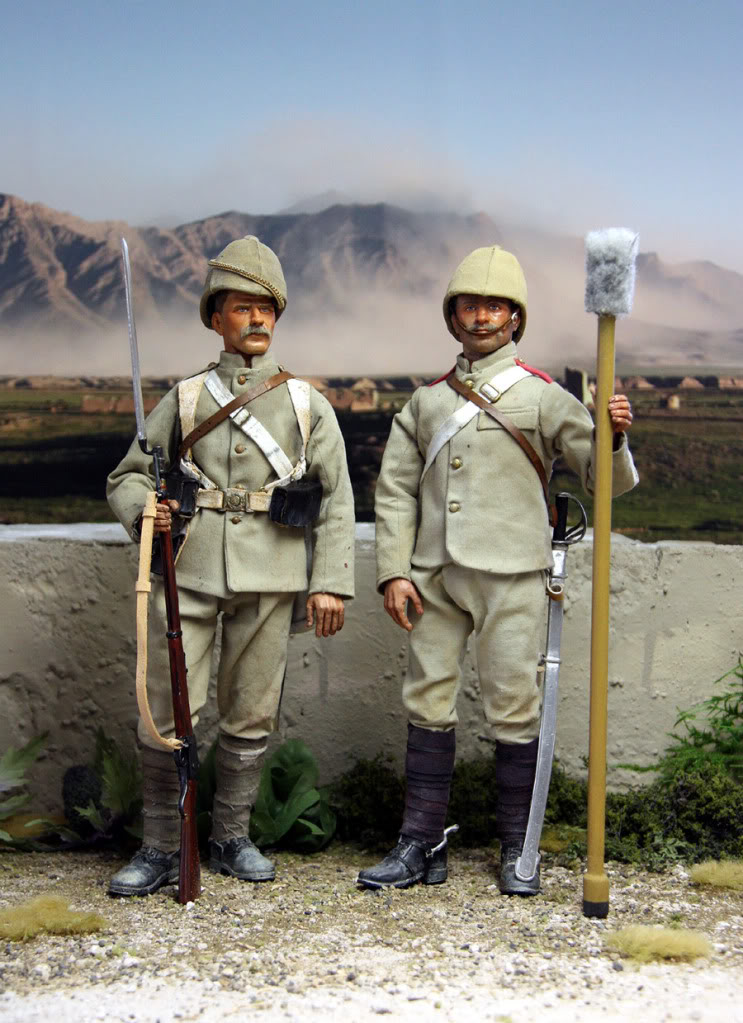
Having lost the 1st Afghan War , you would think that the British Empire might have learned some lessons about underestimating “ native “ foes , and doing a little more reconnaisance .
Just over a year earlier , they had been famously and bloodily defeated by another such set of “ natives “ at Isandlwana in Zululand , 22nd January 1879
Having embarked on another invasion of Afghanistan , they were about to suffer another such disaster .
Before the battle the campaign had gone well for the British.
They had defeated Afghan tribesmen at Ali Masjid, Peiwar Kotal, Kabul, and Ahmed Khel, and they had occupied numerous towns and villages, including Kandahar, Dakka, and Jalalabad.
Ayub Khan, Shere Ali's younger son , set out towards Kandahar with a small army in June 1880, and a brigade under Brigadier-General Burrows was detached from Kandahar to oppose him. Burrows' brigade, some 2,500 strong with about 500 British troops including a battery of 9-pr guns, advanced to Helmand, opposite Gereshk, to oppose Ayub Khan. Burrows fell back to a position at Kushk-i-Nakhud, halfway to Kandahar where he could intercept Ayub Khan if he headed for either Ghazni or Kandahar.
On the afternoon of the 26th July information was received that the Afghan force was making for the Maiwand Pass a few miles away Burrows decided to move early the following day to break-up the Afghan advance guard. At about 10 am horsemen were seen and engaged, and the brigade started to deploy for battle.
Burrows was not aware that it was Ayub's main force.
The Afghans, who numbered 25,000 including Afghan regular troops and five batteries of artillery including some very modern Armstrong guns.
The battle opened with the RHA battery galloping away to the left , where they opened fire. This slightly premature action commited Burrows to forming his line on this battery , when there was a vastly better position behind him in a large nullah .
The Afghan guns gradually came into action and a three hour artillery duel ensured at an opening range of about 1700 yards . The masses of Afghan Infantry eventually advanced , but were effectively stopped by the massive firepower of the three Infantry battalions and artillery , until the British smoothbore guns on the left ( captured from the Afghans earlier and served by men from the 66th ) expended their ammunition and withdrew to replenish it.
This enabled the Afghans to rush forward from a covered nullah and force the left hand battalion back. The Indian infantry regiments forming the left flank then gave way in a great wave to the right, where the 66th Regiment, the backbone of the defence, were swept away by the pressure of the Ghazi attack.
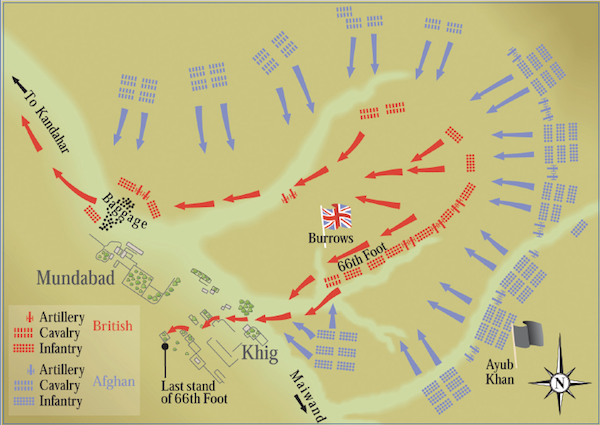
E Battery / B Brigade Royal Horse Artillery (Captain Slade commanding) and a half-company of Bombay Sappers and Miners under Lieutenant Henn (Royal Engineers) stood fast, covering the retreat of the entire British Brigade. E/B RHA kept firing until the last moment, two sections (four guns) limbering up when the Afghans were 15 yards away, but the third section (Lt Maclaine) was overrun.
This action was the subject of the Caton Woodville painting .

E/B RHA came into action again some 400 yards back. The Sappers and Miners retreated as the guns withdrew. Henn and 14 of his men afterwards joined some remnants of the 66th Foot and Bombay Grenadiers in a small enclosure at a garden in a place called Khig where a determined last stand was made.
Though the Afghans shot them down one by one, they fired steadily until only eleven of their number were left, and the survivors then charged out into the masses of the enemy and perished. Henn was the only officer in that band and he led the final charge .
 The retreat to Kandahar (27-28 July 1880)
The retreat to Kandahar (27-28 July 1880)Word of the disaster reached Kandahar the following day and a relief force was dispatched. This met the retreating force at Kokeran.
The British were routed, but managed a withdrawal due to their own efforts and the apathy of the Afghans. Of the 2,476 British troops engaged, the British and Indian force lost 21 officers and 948 soldiers killed, and eight officers and 169 men were wounded. Ayub Khan’s army is thought to have had nearly 2000 casualties .
Two Victoria Crosses were awarded for acts of valour performed during the battle and during the retreat to Kandahar. Both medals went to members of E/B Battery, RHA. One was awarded to Sergeant Patrick Mullane, for attempting to save the life of a wounded colleague during the withdrawal of their battery from the field; the other went to Gunner James Collis , who during the retreat to Kandahar drew the attention of enemy fire upon himself instead of upon wounded colleagues.
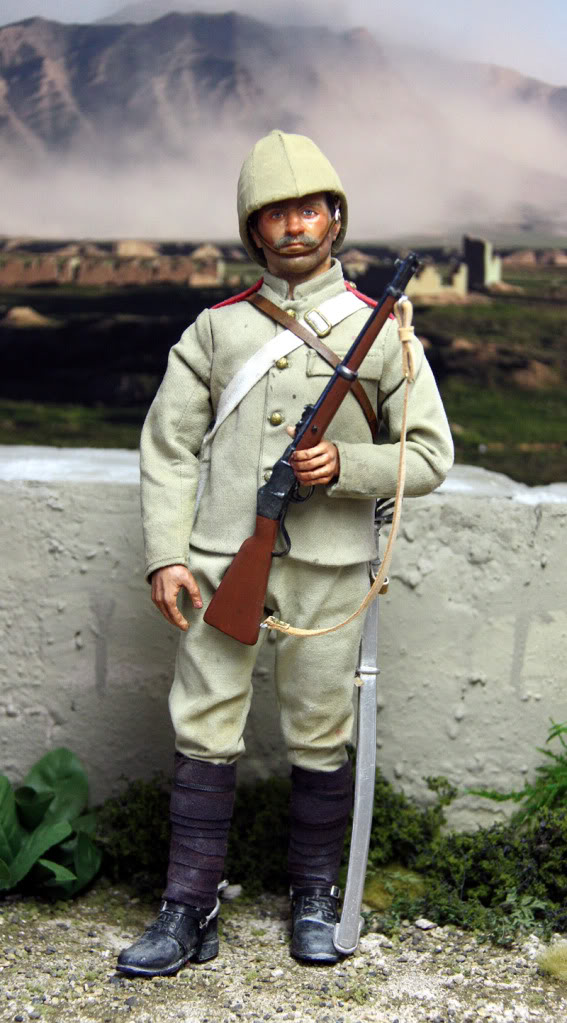
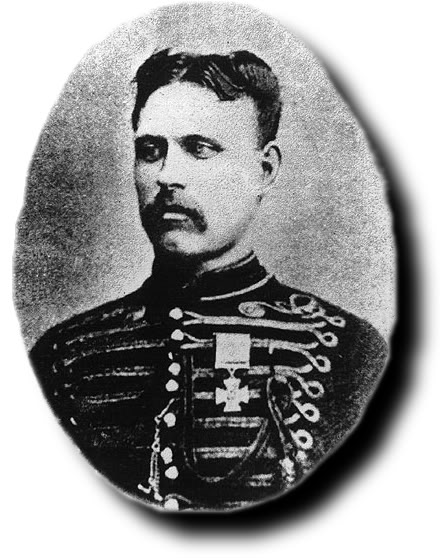
*******************************************************************
The figures themselves are standard DML bodies, chests reduced.
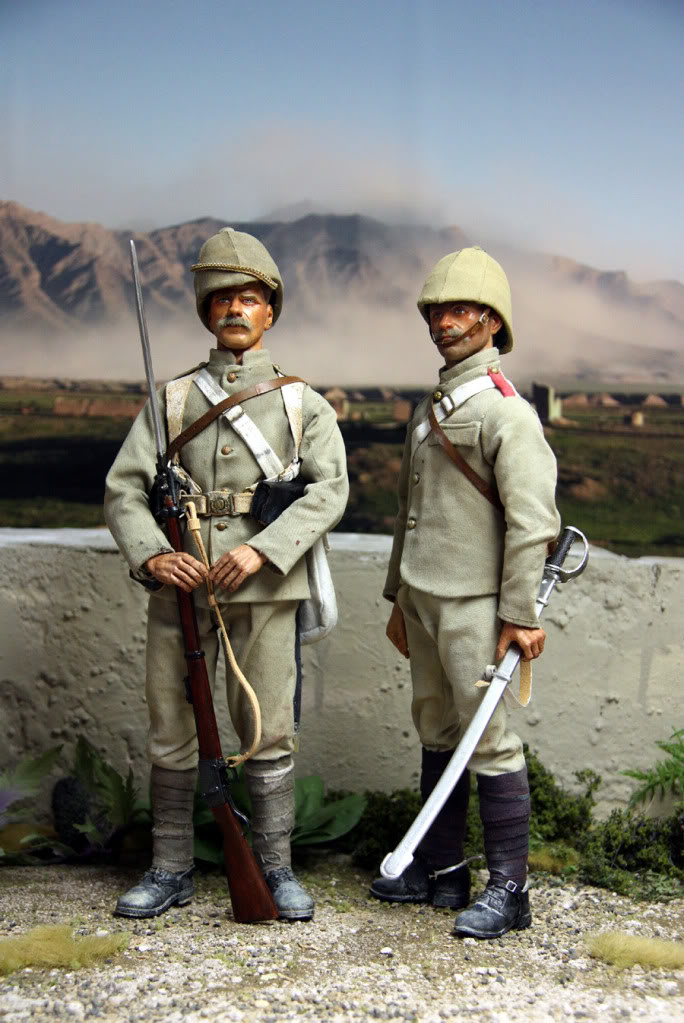
All the uniform and equipment is homemade. The information is largely from a Military Illustrated article by Michael Barthorp.
I get KD fabric from the numerous charity shops here in York : you can get a pair of trousers or a skirt for £3 , and there’s a great variety of fabric weight and colour on offer. Apparently at this early date for khaki a greyer shade was preferred, compared with the sandy colour used later. He has brass shoulder titles, which first came into use about this time.
The helmets are resin ones , with KD covers and curb chains from a cheap necklace .

The equipment is buff ( goatskin ) and calfskin , with brass fittings from wire and cast by the lost wax method .
Waterbottles are an Indian-made pattern , a glass bottle inside a leather cover. Modelled in Sculpey and leather .

The boots are DiD, the puttees cut from home dyed cotton flannel.

The Martini-Henry rifle is one of my own versions , rather more robust than the flimsy DML or DiD versions , fitted with “the Lunger “ the 21” bayonet issued to replace the earlier 17” one.
Gunner Collis has the Martini-Henry carbine, two of which were carried on each artillery limber, a 1857 pattern sword , and a rammer (made from a wooden knitting needle) for his 9pdr RML gun , which looked like this

Notice the rather handsome ochre colour used at the time.
There is a memorial in the form of a lion in the centre of Reading to the men of the 66th who fell at Maiwand.

****************************************************************************





